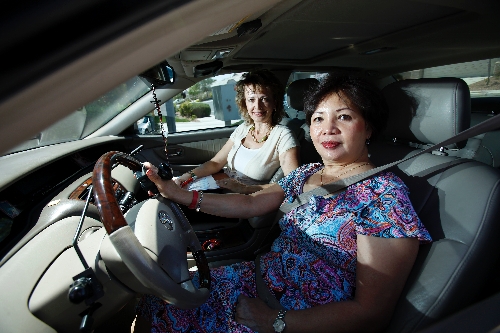Grayer drivers, more traffic crashes? Perhaps not
The first of the baby boomers are older than 65, which means an awful lot of the driving population is graying, whatever the color of their hair.
An analysis by the AAA Foundation for Traffic Safety shows a driver's risk - not only to himself or herself but also to others on the road - begins to increase about age 70, and more rapidly after 75. By 85, the foundation reports, drivers are two to three times more likely to die in vehicular accidents than those fledgling 16- to 17-year-old drivers.
So, do so many older drivers portend a future of widespread carnage on our highways?
"It's really interesting," says Erin Breen, director of the University of Nevada, Las Vegas Safe Community Partnership Program. "It has been the elephant in the room for a long time. No one in our community has really picked up on all of the ramifications for drivers aging in place."
But the picture isn't as bleak as it may seem, safety experts say, for several reasons.
One is that the fatality rate of older drivers tends to be higher largely because of their own comparatively fragile state of health.
"We know that older drivers are overrepresented in fatality numbers," Breen says. "That doesn't necessarily mean that they get in more crashes; it means they simply don't survive the crashes."
Another is that, while older drivers present much more risk to others on the road than, say, middle-aged drivers, that's a per-mile risk, and since they tend to drive less, the risk drops.
And, most importantly, there are things that older people can do to make them better, safer drivers.
Bette LaCombe, zone coordinator for Southern Nevada for the AARP Driver Safety program, notes more than 6,000 Nevadans took the class in 2011. Most of them were retirement age, but LaCombe says the youngest member of her classes was a 20-year-old whose mother had taken it and wanted her daughter to learn the safety strategies.
LaCombe says the four-hour class - which used to be called 55 Alive - is offered about 20 times a month in Southern Nevada. Many of the sessions are at senior centers and in senior communities, as well as at hospitals, churches and car dealerships.
The class has several facets.
"We talk about you getting physically ready to get behind the wheel," LaCombe says. "We recommend you exercise and get your eyes checked."
It covers safety strategies, such as adjusting rearview mirrors to reflect two lanes of highway on each side of the vehicle rather than one. And picking out a stationary object, such as a light pole, and checking the point at which the vehicle in front of you passes it and waiting 3 seconds before you pass the same point - which negates the old 10-mph-per-car-length rule of thumb.
"It's three seconds whether you're going 10 mph or 80," LaCombe says.
Also addressed are scanning techniques, in which drivers are taught to always scan the area around them.
"If you're stopped for a red light, you should be scanning always," LaCombe says. "Talk to the window, as opposed to talking to your friend. Watch the car getting ready to go through the red light. You want to make sure there's not a pedestrian who all of a sudden wants to run right in front of you. Try to see if you see an ambulance or some flashing light. Be always aware of what's around you."
The class also reviews laws, some of which many drivers are unsure about. One example, LaCombe says, is the law regarding yielding to pedestrians. Drivers must wait until the pedestrian has crossed into the lanes of traffic opposite to where the motorist is heading before proceeding through the intersection, she says.
(The class represents a financial incentive, in addition to reducing damage to a person's vehicle and others'. Jake Sunderland, public information officer for the Nevada Division of Insurance, says state law requires that seniors 55 and older who take an approved driver-safety course and meet other conditions - such as no at-fault accidents and no violations - get an insurance discount for three years. While the law doesn't mandate the discount, he says, most commonly it's 5 percent.)
Breen says much of the physical toll of aging affects driving - "simple things that in daily existence you don't notice (are) declining," she says. "The ability to look over your shoulder. Depth perception and not being able to gauge how fast a car is coming. There are going to be certain things you can't fix."
But some of those things can be measured objectively, and sometimes tactics can be employed to help counteract them.
Debbie Hansen, an occupational therapist and owner of Adaptive Driving Rehab, is a rehab driving specialist. As such, she is trained to evaluate a person's ability to drive, using objective measures.
"They have done research for specific tests and specific outcomes that have to be achieved for you to be a safe driver," she says. "What they have kind of pared it down to is reduced reaction time, inability to move the neck to look at blind spots and difficulty with visual attention and scanning. My job is to point out not only the deficits and the strengths, but also to teach people to overcome those."
For someone with poor neck mobility, for example, she says mirrors that extend the field of vision can be used. Some visually impaired people, she adds, can benefit from special lenses that are like a scope attached to the top of prescription eyeglasses.
"You dip your head down to see distances that you wouldn't ordinarily capture," she says.
"It's my responsibility as a therapist to know what strengths they have in order to drive, what deficits they have that are deal-breakers. A certain level of dementia - I'm sorry, that's a deal-breaker."
Hansen says the information she gleans from evaluations is not shared with the Nevada Department of Motor Vehicles.
"The DMV wants information from the physician directly," she says.
Breen says anyone who's concerned about the driving of, say, an aging parent, can ask the person's physician to refer him or her to the DMV.
Hansen says driving evaluations aren't covered by Medicare, which "doesn't consider driving an essential of daily living. That means the person has to have enough self-awareness to decide, 'Hmm, I wonder if my driving skills are up to snuff.' " The evaluation, she says, costs $650 and runs three hours or longer. An evaluation involves testing, and then Hansen gets into the car while the person drives.
"I need to see for myself how they use their strengths and weaknesses," she says.
Breen says that's a good way to evaluate the driving of any aging person.
"Drive with your parents," she says. "Be a passenger. Start looking for things like dings on their car."
And someone concerned about his or her own driving could ask a competent person to ride with him or her.
Breen says the positioning of senior communities on the outer fringes of the community poses problems because public transportation in outlying areas tends to be less available than it is in the inner city.
"Not having good infrastructure, as far as transportation goes, kind of forces older drivers to drive longer than they should," she says.
She also cautions against being caught up in the numbers.
"It's totally not an age thing," Breen says. "There's lots of 65-year-olds that drive great. There's lots of 75-year-olds that drive great. There's lots of 55-year-olds that don't."
But as a rule, she says, older drivers might be less of a threat than statistics would suggest.
"They are more careful," she says. "They are the most likely to wear their seat belts. They are the least likely to drink and drive. And of course they're the least likely to drive with a cellphone.
"They take the business of driving more seriously."
"I think we police ourselves very well when driving," says LaCombe, who's 66. "We're not known for cutting people off and speeding."
But she adds a word of caution.
"A car is a lethal weapon and can kill people. We want you to be safe and not hurt somebody."
Contact reporter Heidi Knapp Rinella at hrinella@review journal.com or 702-383-0474.
MORE INFO
For information on AARP Driver Safety classes, call (888) 227-7669 or visit AARP.org/drive. Classes normally are $14; AARP members get a $2 discount.
During July and August, anyone with a job in the field of education can take the class for $5. And in November, veterans and their spouses can take the class for free.




























